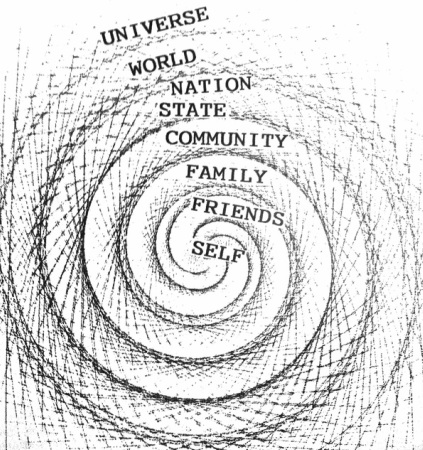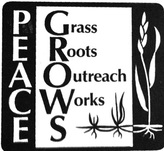Improving conditions can be assured if enough people come together with real dedication and clear, practical vision of objectives.
Let's begin our last session by reviewing the "Various Uses of Nonviolence", as a short article from the original Alternatives to Violence Workbook. Then we will listen to a short interview of Martin Luther King Jr., a man who used nonviolence in most situations.
The Various Uses of Nonviolence:
|
Martin Luther King Jr: | ||
The Cases for Reflection at the end of this session are examples of the
"Uses of Nonviolence."
|
Now let's listen and focus on an article entitled "Assuring Nonviolence"."People throughout history have had marvelous plans. Yet too often they remained just that, plans. Most are never implemented. Why? How can we avoid the same tragic experience here?" | ||
Could the following process inspire us to keep working for Alternatives to Violence?
|
According to Mirriam-Webster (2013), to image as a transitive verb can be: 1. To call up mental picture(s) or 2. To describe or portray in language especially in a vivid manner. Use of mental images can alter a person's perceptions or behaviors. |
Here to move slide
|
Now two case studies expressing humbleness and eloquence.
Case Study: |
Chief Seattle's Message
|
|
In 1854, Chief Seattle, leader of the Suquamish tribe in the Washington territory, delivered this prophetic speech to mark the transferal of ancestral Indian lands to the federal government of the U.S.A.
The Great Chief in Washington sends word that he wishes to buy our land. The Great Chief also sends us words of friendship and goodwill. This is kind of him, since we know he has little need of our friendship in return. But we will consider your offer. For we know that if we do not sell, white man may come with guns and take our land. How can you buy or sell the sky, the warmth of the land? The idea is strange to us. If we do not own the freshness of the air and the sparkle of the water, how can you buy them? The red man has always retreated before the advancing white man, as the mist of the mountain runs before the morning sun. But the ashes of our fathers are sacred. Their graves are holy ground, and so these hills, these trees, this portion of earth is consecrated to us. We know that the white man does not understand our ways. One portion of land is the same to him as the next, for he is a stranger who comes in the night and takes from the land whatever he needs. The earth is not his brother, but his enemy, and when he has conquered it, he moves on. He leaves his fathers’ graves behind, and he does not care. He kidnaps the earth from his children. He does not care. His fathers’ graves and his children’s birthright are forgotten. He treats his mother, the earth, and his brother, the sky, as things to be bought, plundered, sold like sheep or bright beads. His appetite will devour the earth and leave behind only a desert. So we will consider your offer to buy our land. If we decide to accept, I will make one condition: The White man must treat the beasts of this land as his brothers. |
I am a savage and do not understand any other way. I have seen a thousand rotting buffaloes on the prairie, left by the white man who shot them from a passing train. I am a savage and l do not understand how the smoking iron horse can be more important than the buffalo that we kill only to stay alive.
What is man without the beasts? If all the beasts were gone, men would die from a great loneliness of spirit. For whatever happens to the beasts, soon happens to man. All things are connected. This we know. The earth does not belong to man, a man belongs to the earth. This we know. All things are connected like the blood which unites one family. All things are connected. Whatever befalls the earth befalls the sons of the earth. Man did not weave the web of life; he is merely a strand in it. Whatever he does to the web, he does to himself. So will consider your offer to buy our land. If we agree, it will be to secure the reservation you have promised. There, perhaps, we may live out our brief days as we wish. When the last red man has vanished from this and his memory is only the shadow of a cloud moving across the prairie, these shores and forests will still hold the spirits of my people. For they love this earth as the newborn loves its mother’s heartbeat. So it we’ve sell you our land, love it as we’ve loved it. Care for it as we’ve cared for it. Hold in your mind the memory of the land as it is when you take it. And with all your strength, with all your mind, with all your heart preserve it for your children, and love it. . .as God loves us all. One thing we know. Our God is the same God. This earth is precious to him. Even the white man cannot be exempt from the common destiny. We may be brothers after all. We shall see. |
|
The history, culture, and lifestyle of the Suquamish impressed respect and love for the land on their young and old. All lived by these values and it was a clear vision to maintain the condition of their homeland. Chief Seattle looked to the future of the world and recognized that the culture of the European settlers would lead to violence and disrespect against the creatures and the land, after its purchase. Chief Seattle tries to lead the settlers through pleads in his message. However, there was a joint decision to sell the land and move to the reservations as an attempt to save the Suquamish people from slaughter.
| ||
Case study: |
The Shakertown PledgeMany people throughout the country have come to believe that if the world family is to be cared for and fed, American citizens need to adopt new ways of life in which they consume closer to their fair share of the earth's resources. The network of people moving thus to simplify their lives includes individuals and groups from many backgrounds and interests who are committed to bring about a just world standard of living. One such group is the Shakertown Pledge Group, who act out of a religious or spiritual concern, They are united in their desire to struggle to live their commitment and to work for the political, economic, and social change necessary to make global justice a reality.
On April 30, 1973, The Shakertown Pledge was written to express their concern and shared commitment. Several other groups, including nonreligious groups across the country, have created their own pledges or used The Shakertown Pledge as a focus for discussion. We include The Shakertown Pledge and the authors comments about it as an example of what can be done and encourage you to write your own statement of concern or contact the Shakertown Pledge Group. The Shakertown Pledge originated when a group of religious retreat center directors gathered at the site of a restored Shaker village near Harrodsburg, Kentucky. A number of us were personally moved by the global poverty-ecology crisis we saw all around us, and we covenanted together to reduce our levels of consumption, to share our personal wealth with the world's poor, and to work for a new social order in which all people have equal access to the resources they need. We have since been joined by others. |
Recognizing that the earth and the fullness thereof is a gift of our gracious God, and that we are called to cherish, nurture, and provide loving stewardship for the earth’s resources. And recognizing that life itself is a gift, and a call to responsibility, joy, and celebration.
I make the following declarations:
|
|
As mentioned in the passage above, The Shakertown Pledge Group was able to share wealth and improve social conditions through a joint and dedicated effort of their members. They decided to changed from their self-serving habits to turn their attentions to the needs of others. There was a vision for improved circumstances in our global society. This session emphasizes the idea that things can truly be accomplished if this dedication, as well as a clear and practical vision, is present.
|
*Please note the Alternatives to Violence Course uses this pledge as an example. We encourage writing your own or finding another appropriate for you.
Everything is Connected in the Pattern of Life
|
This course examines all kinds of conflict and violence at all levels from interpersonal to community to global and everything in between. This chart portrays how everything is connected. Did you ever realize that you, just by being born, are part of these communities?
Everything in life is, in some way, connected. This means that all kinds of conflict are possible and that all kinds of responses, violent and non-violent, are possible.
|
Review and Reflect
Major point to remember:
Improving conditions can be assured if enough people come together with real dedication and a clear, practical vision of objectives.
To Reflect: Optional Activities
Materials located on the "Extra" page for applications #1 & #2
#1: Analyze at least two Case Studies: 7A, 11C, 14B, 16A
#2: Movie Assignment: View "Invictus" and answer the corresponding questions
#3: Application:
The behavior of parents, siblings, teachers, and friends are examples for the children that spend significant time with them. Even the words we use are powerful. Do we acknowledge the needs and wants of others but respectfully make our own case with I-statements? Or do we give in to our anger by shouting, name-calling, or even resorting to hitting?
This course can help us do better. The following application is from a lesson written by the editor of the Alternatives to Violence Workbook and tested with teachers in schools of all grade levels. We hope you find something helpful.
#2: Movie Assignment: View "Invictus" and answer the corresponding questions
#3: Application:
The behavior of parents, siblings, teachers, and friends are examples for the children that spend significant time with them. Even the words we use are powerful. Do we acknowledge the needs and wants of others but respectfully make our own case with I-statements? Or do we give in to our anger by shouting, name-calling, or even resorting to hitting?
This course can help us do better. The following application is from a lesson written by the editor of the Alternatives to Violence Workbook and tested with teachers in schools of all grade levels. We hope you find something helpful.
| Alternative Role Models Download |


